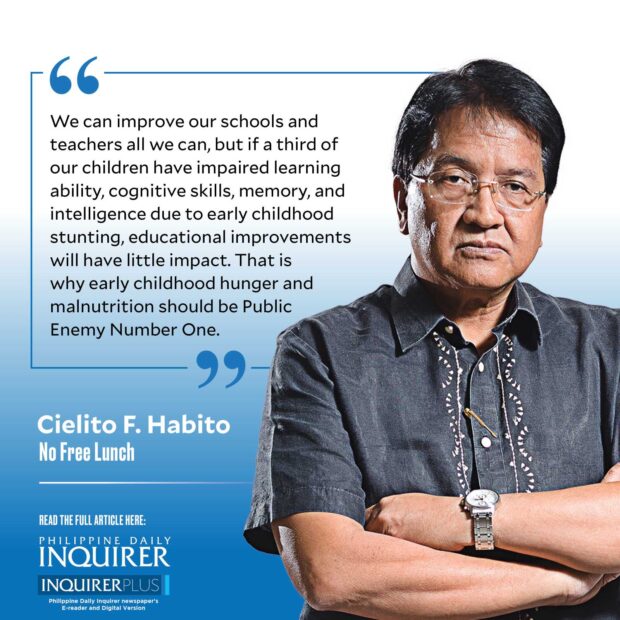Doing feeding right
Child feeding programs have been around for decades, but today I see seemingly much wider interest in doing them and doing them right. Perhaps we’re all realizing that our society’s ills spanning the human, social, economic, political, and cultural dimensions of national development trace ultimately to poor health and nutrition in our children, past and present. The problem has been with us for generations and is also worse here than in most of our neighbors.
Most would pin the blame on education, especially with our bottom ranking in various world education indicators. We’ve also been reported to have the third lowest average IQ of all 10 Asean nations. I’ve constantly argued that the problem is not just about schools, teachers, and textbooks, but traces ultimately to malnourished and hungry children. The problem is that 90 percent of human brain development happens before age 5, and a child severely underfed at that tender age is stunted, not only physically, but more importantly, mentally as well. It afflicted nearly one in every two Filipino children 5 years and below in the 1980s, and now still about one in three—higher than in most of our neighbors.
We can improve our schools and teachers all we can, but if a third of our children have impaired learning ability, cognitive skills, memory, and intelligence due to early childhood stunting, educational improvements will have little impact. That is why early childhood hunger and malnutrition should be Public Enemy Number One. The President has rightly vowed to stamp out hunger among Filipinos by his term’s end, and we all pray that it will not be mere hollow rhetoric, but rather a true legacy to the nation.
The battle cry is to feed the youngest of our children (and that means pregnant and breastfeeding mothers, too), and over so many years, people who have worked hard to do so have gained valuable insights for those who wish to do the same.
First, school feeding programs are good, but they are too late because school children are past the critical age before which stunting needs to be arrested. Peru made rapid strides against stunting by shifting emphasis from school feeding to feeding kids below school age. Second, feeding children is not enough; any such program must come with regular monitoring of their weight and height to assess whether progress is being made, i.e., whether a child’s weight and height are indeed normalized. And to be useful, such weighing and height-taking must be done with the right instruments, especially standard and precisely calibrated weighing scales, not just any multipurpose or bathroom scales most easily on hand. I noticed in one such weighing and height-taking session that children often struggled and cried through the process, likely affecting the accuracy of the measurements, apart from taking more time and effort. An observer suggested “gamifying” the process, a good idea that could help eliminate the children’s trauma, and thereby improve efficiency and accuracy.
Often accompanying feeding programs are efforts to get parents and local folk to raise more food for themselves, and community gardens tend to be a top-of-mind idea. But I’ve often heard seasoned practitioners declare that community gardens simply don’t work. Volunteering one’s individual effort for collective benefit seems hard for common folk to do, and worse, there will always be free riders who would steal the harvest in the dead of night—or even broad daylight. Better success has been achieved with programs where individual households plan for themselves in backyard plots or even vertically in containers. Advancement for Rural Kids (ARK) does it with an interesting twist, featuring a vegetable exchange: Participating families are asked to farm in their backyards and contribute three of their favorite vegetables in regular exchange meets, then go home with a fair share of over 20 vegetables grown by their neighbors. ARK reports a good track record on the program’s sustainability.
Groups pursuing various such programs would do well to talk to, learn from, and help one another. This way, they could collectively achieve far more than they could as disparate initiatives.
—————–
cielito.habito@gmail.com

















